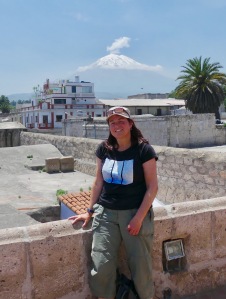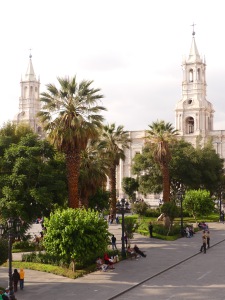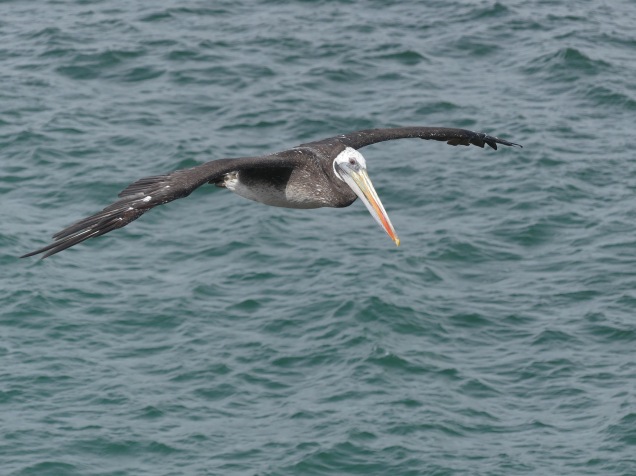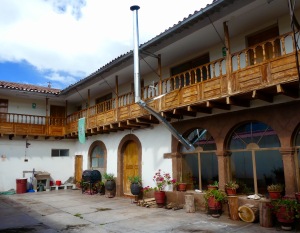A is for Arequipa and artisanal alpaca hats

 Arequipa was the first town I properly arrived in, having crossed the overland border between Arica in Chile and Tacna in Peru. The old city is full of character, beautiful cobbled streets, it nestles below three volcanoes, and the food has a style all of its own. I especially liked Rocoto Relleno, a large stuffed red chili, with a solid spicy kick. The monastery of Santa Catalina is an eye-opening revelation into how nuns from wealthy Spanish families lived – no vow of poverty here and only the first Vatican council changed their lifestyle into one more of community living.
Arequipa was the first town I properly arrived in, having crossed the overland border between Arica in Chile and Tacna in Peru. The old city is full of character, beautiful cobbled streets, it nestles below three volcanoes, and the food has a style all of its own. I especially liked Rocoto Relleno, a large stuffed red chili, with a solid spicy kick. The monastery of Santa Catalina is an eye-opening revelation into how nuns from wealthy Spanish families lived – no vow of poverty here and only the first Vatican council changed their lifestyle into one more of community living.
 An alpaca hat with ear flaps and tassels is the must-have item for overnight stays in Colca Canyon or the Inca Trail. There’s a moment on every trek when the baseball caps and wide brimmed straw trilby hats vanish and out come all the alpaca hats we’ve been cajoled into purchasing from the wizened knitting ladies in every market, tourist stop, or café. You can try to resist, but the cold nights in Puno or Cusco mean the alpaca hat will get you in the end! Mine’s reversible, just sayin’! 😉
An alpaca hat with ear flaps and tassels is the must-have item for overnight stays in Colca Canyon or the Inca Trail. There’s a moment on every trek when the baseball caps and wide brimmed straw trilby hats vanish and out come all the alpaca hats we’ve been cajoled into purchasing from the wizened knitting ladies in every market, tourist stop, or café. You can try to resist, but the cold nights in Puno or Cusco mean the alpaca hat will get you in the end! Mine’s reversible, just sayin’! 😉
B is for the Ballestas Islands
Dubbed the “poor person’s Galapagos”, you can smell the guano in these tiny rocky outlets, teeming with pelicans, piqueros (Peruvian boobies, very like our gannets), cormorants, gulls, and a colony of Humboldt penguins, as well as sea lions. There have even been guano wars, a valuable commodity for fertiliser use. I loved my boat ride to the Ballestas – it just wasn’t nearly long enough!



B is also for bus-cama! Peru has amazing long distance buses with deeply reclining seats, I travelled cheaply and in comfort on Flores, Palomino and Cruz del Sur, the latter for me easily the best, especially for an overnight trip. I met lots of backpackers who loved Peru Hop, a dedicated tourist bus between Lima and Cusco, Nazca, Ica, Arequipa and Puno that picks up directly from hostels, avoiding the need for taxis from bus terminals. I enjoyed the crazy bustle of the bus terminals & travelling with Peruvians though!
C is for Condors in Colca Canyon
At 3270 metres, Colca Canyon is twice as deep as the Grand Canyon, with occasional condors circling overhead (we saw both juvenile and adults on our first day), a river that was in full raging torrent below, tiny villages clutching to its trademark steep sides, and full of pre-Inca history, including Wari tombs. On a three day, two night trek we stayed in the tiny hamlet of San Juan de Chuccho, still only reachable by horse or foot, in a straw roofed hut with candles for light. An afternoon in the oasis at Sangalle at the bottom is a wondrous thing before a punishing 2-3 hour almost vertical zig-zagging climb out the next morning!
PS I could include so many more Peruvian delights starting with C – ceviche, Cusco, coffee, cacao & chocolate making, and of course coca leaves, the chewing of which got me over the Inca Trail mountain passes! I would have loved to go to Cajamarca, but road and bridge damage following the terrible flooding in the north of Peru meant it was the C I missed.
D is for the desert
 I’d always associated Peru with mountains and jungles rather than the desert, which spans Peru’s coastline. Arriving across the border from Arica to Tacna, to find an immense arid wasteland with tiny “tomatierras” (land grabs) peppering the view, and bussing up the northern route from Nazca up to Paracas and Lima was therefore a real eye opener! In Tacna, despite the desert, there is an ice rink!
I’d always associated Peru with mountains and jungles rather than the desert, which spans Peru’s coastline. Arriving across the border from Arica to Tacna, to find an immense arid wasteland with tiny “tomatierras” (land grabs) peppering the view, and bussing up the northern route from Nazca up to Paracas and Lima was therefore a real eye opener! In Tacna, despite the desert, there is an ice rink!
E is for earthquakes
 No country with volcanoes is immune from earthquakes, and Peru has seen its fair share. The Inca ingeniously intricate mortar-free walls, locked together like jigsaw puzzles and sloping inwards, have proved the test of time, which is why we can still see so many ruins. Sadly, the Spanish-built churches on top of many Inca palaces and temples, did not prove so resilient. Many toppled and had to be rebuilt, like the cathedrals in both Arequipa and Lima.
No country with volcanoes is immune from earthquakes, and Peru has seen its fair share. The Inca ingeniously intricate mortar-free walls, locked together like jigsaw puzzles and sloping inwards, have proved the test of time, which is why we can still see so many ruins. Sadly, the Spanish-built churches on top of many Inca palaces and temples, did not prove so resilient. Many toppled and had to be rebuilt, like the cathedrals in both Arequipa and Lima.
F is for Free Walking Tours
The growing trend of free walking tours of cities is flourishing in Peru, and I joined different tours in Arequipa, Cusco and Lima. They’re usually a mix of city orientation, history, personal storytelling, the personal opinion of often quirky and entertaining guides, and small tastings of food and drink, all for a tip for what you think the tour was worth. The original tours are found at www.fwtperu.com but there are younger competitors such as Free Walking Tours Peru or the Arequipa Free Tour. They’re a great way to meet fellow travellers too.
G is for Guinea Pigs – preferably alive
 The day before I left the UK I visited a friend and her six year old daughter whose pet guinea pig had recently had an eye infection. The vet gave them the choice of euthanasia for £25 or surgical removal of the eye (with a chance it might not survive the anaesthetic) for £400. Initially determined not to spend ridiculous amounts, they decided to sleep on it, and in a morning change of heart, went for the op. Their little furry friend came through fine and was happily running around one eyed as they told me the story. I couldn’t help but think of this every time I saw the cages full of ‘cuys’ kept by most farming families, who pick a few choice ones for the BBQ on special occasions. I never had the heart to eat one! If I could’ve saved one from the grill as a pet it would have been this one!
The day before I left the UK I visited a friend and her six year old daughter whose pet guinea pig had recently had an eye infection. The vet gave them the choice of euthanasia for £25 or surgical removal of the eye (with a chance it might not survive the anaesthetic) for £400. Initially determined not to spend ridiculous amounts, they decided to sleep on it, and in a morning change of heart, went for the op. Their little furry friend came through fine and was happily running around one eyed as they told me the story. I couldn’t help but think of this every time I saw the cages full of ‘cuys’ kept by most farming families, who pick a few choice ones for the BBQ on special occasions. I never had the heart to eat one! If I could’ve saved one from the grill as a pet it would have been this one!
H is for Huarocondo
This Andean village was my base in Cusco, at the charming hospedaje Gringo Wasi, run by Lyle and Lily Walker (he’s American, she’s Peruvian). I loved being outside the tourist bustle, more or less the only gringa in town. During the rides in a colectivo (shared taxi – at one point there were 10 of us in one estate car, I was in the boot with 2 others) into nearby market town Izcuchaca and on into Cusco I was invited for coffee, introduced to a “single gentleman” and asked if I know the bible by a friendly four year old! One chatty co-traveller was surprised to hear the English don’t speak Quechua, main language of the locals here, immediately sharing this breaking news with the whole minibus! On Palm Sunday, the Huarocondo parish church was packed to the rafters, including one extremely frail old lady who was carried in on the back of a sweating relative, and spent the service with her hands raised to heaven.
I is for Inca (obviously!)
“Only my Father can take me from here. And he not accept me killed by men like you. Men with no word. You may be King in this land. But never God. And if you kill me tonight, I will rise at dawn, when my Father first touch my body with light.” (Atahuallpa to Pizarro, Royal Hunt of the Sun)
 I’ve been fascinated with the Inca empire ever since studying Peter Shaffer’s play The Royal Hunt of the Sun at school, which dramatises the final standoff at Cajamarca between Francisco Pizarro and Atahuallpa in 1533. He is seen as the last great Inca although his younger brother Manco Capac led an unsuccessful revolt against the conquistadors and over two centuries later Tupac Amaru II also led an Andean rebellion movement against the Spanish, before being publicly tortured and executed in 1781. But it’s only since coming here that I feel I’ve even begun to get my head around by the sheer ambition and entrepreneurial creativity of the Inca empire, which in the space of less than 100 years managed to expand in four directions (the tawantinsuyu) through the countries of the Andes, and revolutionised agricultural productivity, irrigation systems and food storage. Their reverence for the sun and moon, the stars and three levels of worlds above, around and below (represented by the condor, puma and serpent) is neatly encapsulated by the chakana, or Andean cross, a bronze version of which is now around my neck. It goes well with alpaca hats.
I’ve been fascinated with the Inca empire ever since studying Peter Shaffer’s play The Royal Hunt of the Sun at school, which dramatises the final standoff at Cajamarca between Francisco Pizarro and Atahuallpa in 1533. He is seen as the last great Inca although his younger brother Manco Capac led an unsuccessful revolt against the conquistadors and over two centuries later Tupac Amaru II also led an Andean rebellion movement against the Spanish, before being publicly tortured and executed in 1781. But it’s only since coming here that I feel I’ve even begun to get my head around by the sheer ambition and entrepreneurial creativity of the Inca empire, which in the space of less than 100 years managed to expand in four directions (the tawantinsuyu) through the countries of the Andes, and revolutionised agricultural productivity, irrigation systems and food storage. Their reverence for the sun and moon, the stars and three levels of worlds above, around and below (represented by the condor, puma and serpent) is neatly encapsulated by the chakana, or Andean cross, a bronze version of which is now around my neck. It goes well with alpaca hats.
J is for Jesuits
They were not the first to arrive in Peru, coming well after the Dominicans and Franciscans, but when they got here in 1568, boy did they gild their churches! To a sickening degree for my taste, when all around you find such depths of poverty. Just google Peru’s answer to the Sistine chapel, St Peter’s in Andahuaylillas, a tiny town with a population of just 5,400 in the last census, but with an incongruously immense ornate church! You don’t usually find another church vying for grandeur right next to a cathedral, but that’s exactly what you’ve got in Cusco, where they had to be warned to stop their lavish adornments at the Compania de Jesus church in the Plaza de Armas. Increasingly seen as a threat to traditional church and state powers, they were expelled from Latin America by Spanish King Carlos III (with complicity of Pope Clement XIV) in 1767, and only allowed back after 1814.
K is for Kola, Inca Kola

L is for llamas
 Sure footed on mountainsides, used to carry stuff like mules and domesticated for their meat, they’re not prized for their wool in the way that alpaca and vicuña are. But it was the llamas on the Inca trail and idly wandering around Machu Picchu that caught my heart, especially the females. I’m a feminist but … I’d kill to have the eyelashes of a female llama.
Sure footed on mountainsides, used to carry stuff like mules and domesticated for their meat, they’re not prized for their wool in the way that alpaca and vicuña are. But it was the llamas on the Inca trail and idly wandering around Machu Picchu that caught my heart, especially the females. I’m a feminist but … I’d kill to have the eyelashes of a female llama.
M is for Machu Picchu (how could it not be!)
They say it’s the journey, not the destination, and usually I’d totally agree, but Machu Picchu has to be the exception! It did matter how I arrived though, and I’m so glad I didn’t just come up on the bus or the walking trail from Aguas Calientes but chose to walk for three days, then finally climb the 50 metre high stone ladder up to the Sun Gate from where a I could only gaze down and marvel, then slowly make my way down the final kilometre to the classic view at the Watchman’s Hut. If you are physically able to do the Camino del Inka, then do it! If not, Machu Picchu is a wondrous, brilliant, mysterious and glittering citadel however you arrive there.
M is also for Muña, an Andean variety of mint and my favourite tea whilst in Peru, and for mummies (fans of skeletons in foetal positions won’t be disappointed!), Miraflores in Lima (great district to stay in with fab restaurants), or the circular terraces of the Inca agricultural experimentation centre at Moray.

Click here for the second part of my A-Z of Peru, from Nasca to Zarcillo!







Lovely blogs Barbara, how can you fail to have a great time and fabulous experiences in Peru! They have brought back so many wonderful memories for us as we lived in the Colca Valley for 2 years….nearly 40 years ago now. Sounds as though the magic is still there and look forwards to hearing more about your travels.
LikeLiked by 1 person
You lived in the Colca Valley? Wow! What were you doing there?
LikeLike
Big engineering job taking water from the hills through tunnels down to the coastal plain/pampas at Siguas, one of largest irrigation schemes ever built. Original stage started mid seventies and finished 90 ish. Think 2nd phase started 2014 to build dams and hydro schemes. You must have past the camp where we lived, though I believe it is abandoned now. Enjoy rest of your travels.
LikeLiked by 1 person
Reblogged this on Vietnam Travel & Trade Portal.
LikeLike
Thank you so much for sharing!
LikeLike